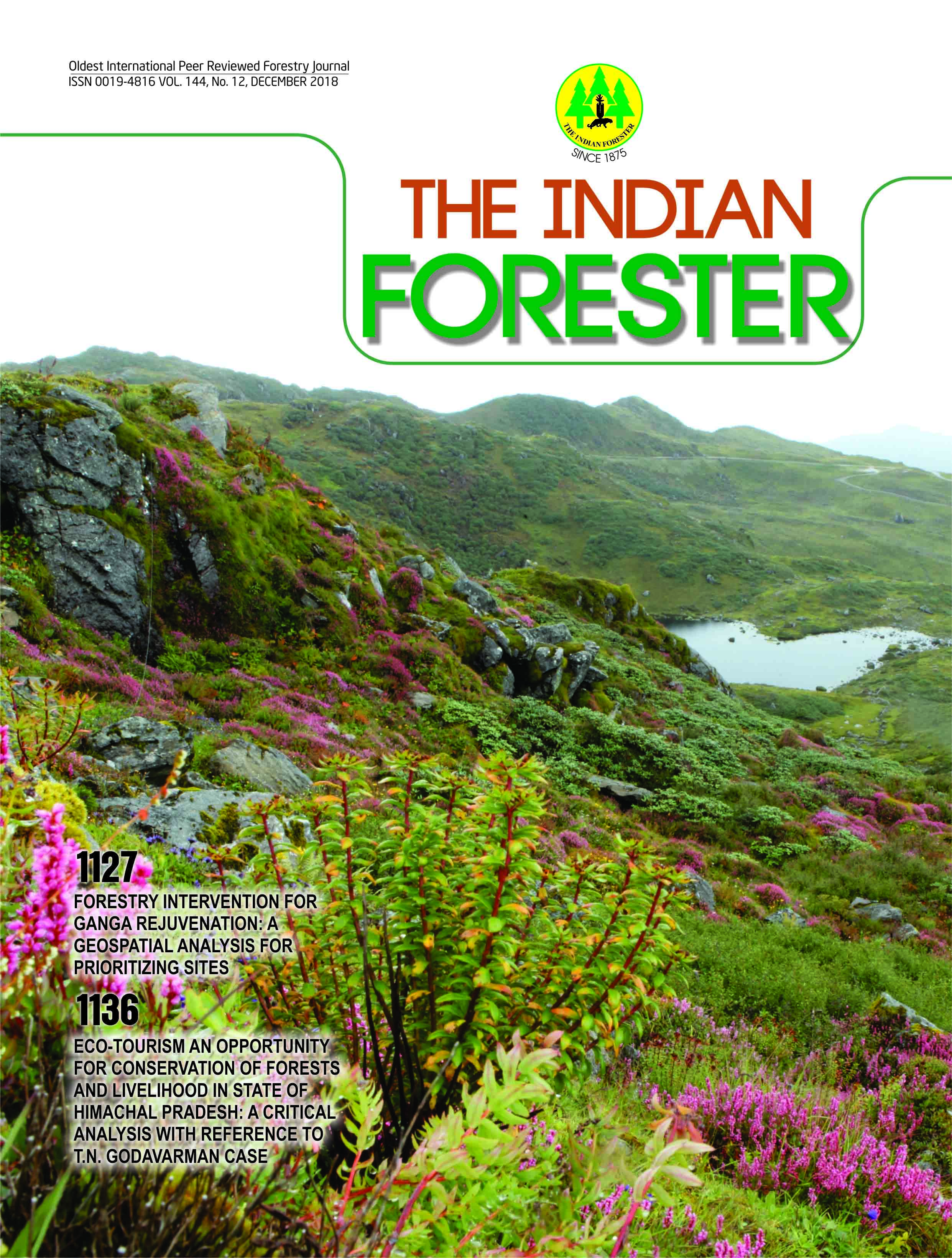Population Structure and Regeneration of Mallotus philippensis in Sal Forests of Kumaun Himalaya
DOI:
https://doi.org/10.36808/if/2018/v144i12/141851Keywords:
Mallotus Philippensis, Associate tree species, Sal forest type and regenerationAbstract
Present study deals with the population structure and regeneration of Mallotus philippensis in different forests i.e. sal dominant, sal mixed and sal open canopy forests of Kumaun Himalaya of Uttarakhand. The density of seedlings, saplings and trees ranged from 920 -1200, 13-160 and 7-127 ind.ha'', respectively. As far as regeneration of Mallotus philippensis Is concerned. It was found good regeneration in sal mixed forest and sal open canopy forest, whereas the sal dominant forest had shown fair regeneration. On the basis of study, it is concluded that the forest site which has sufficient nutrient, moisture and proper availability of sunlight, the regeneration of Mallotus philippensis was good.References
Adhikari B., Kapkoti B„ Lodhiyal N. and Lodhiyal L.S. (2017). Structure and Regeneration of Sal (Shorea robusta Gaertn.f.) Forests in Shiwalik Region of Kumaun Himalaya, India.Indian J. Forestry, 40 (1):1-8.
Barker P.C.J. and Patrik J.B.K. (1994).Phyllocladusasplenifolius: variability in the population structure of the regeneration niche and dispersion pattern in Tasmanian forest. Australian J. Botany, 4 2 :163-190.
Basyal S., Lakhak H.D. and Devkota A. (2011). Regeneration status of Shorea robusta (Gaertn) In Tropical forest of Palpa district, Central Nepal. Scientific World, 9 (9):53-56.
Bohra C.S., Lodhiyal L.S. and Lodhiyal N. (2010). Forest stand structure of Shiwalik region of Nainital district along an altitudinal gradient In Indian Central Himalaya. New York Science Journal, 3 (12):82-90.
Gangwar M., Goel R.K. and Nath G. (2014). Mallotus philippensis IVIuell. Arg. (Euphorbiaceae):Ethanopharmacology and Phytochemistry Review.Biomedical Research international. 13 pp.
Kapkoti B, Adhikari B., Lodhiyal N. and Lodhiyal L.S. (2016).Structure and Diversity of Sal Forests in Government and Community Management Systems in Kumaun Region of Central Himalaya. Current World Environment, 11 (1):126132.
Misra R. (1968). Ecology Work Book. Oxford and IBH Publishing Company, Calcutta 244.
Paine R.T. (1966). Food web complexity and species diversity. American Naturalist, 100:65- 75.
Pathak G.C. (2008). Vegetation analysis and productivity of Shorea robusta Gaertn. f. and Pinus roxburghii Sarg. in Kumaun Himalaya. Ph.D. thesis, Kumaun University.
Pathak S.D. and Shukla R.P. (2004). Population structure and sex ratio of Mallotus philippensis IVIuel. Arg. within forest vegetation of north-eastem UP, India. Tropical Ecology, 45 (2):271-280.
Pokhriyal P., Uniyal P., Chauhan D.S. and Todaria N.P.(2010). Regeneration status of tree species in forest of Phakot and Pathri Rao Watershead in Garhwal Himalayas.Cunrent Science, 98 (2): 171-175.
SaxenaA.K. and Singh J.S. (1982). APhytosociological analysis of woody species in forest communities of a part of Kumaun Himalaya. Proceedings Indian Academy of Sciences, 91:529-549.
Shankar U. (2001). A case study of high tree diversity in a Sal (Shorea robusta) -dominated lowland forest of Eastern Himalaya: Floristic composition, regeneration and conservation. Current Science, 81:776-786.
Sharma J. and Varma R. (2011). A Review on Endangered plant of Mallotus philippensis (Lam.) Muell. Arg.Phanvacologyonline, 3:1256-1265.
Shukla R.P. and Ramakrishnan P.S. (1986). Architecture and growth strategies of tropical trees in relation to successional status. J. Ecology, 74:33-46.
Tlwari A.K., SaxenaA.K. and Singh J.S. (1985). Inventory of forest biomass for Indian central Himalaya. In: Environment Regeneration in Himalaya: Concepts and Strategies (Singh JS eds). Central Himalayan Environmental Association and Gynodya Prakashan, India, 236-247pp.
Wealth of India (2003). C.S.I.R. Publication. 9-32.
Downloads
Downloads
How to Cite
Issue
Section
License
Unless otherwise stated, copyright or similar rights in all materials presented on the site, including graphical images, are owned by Indian Forester.





